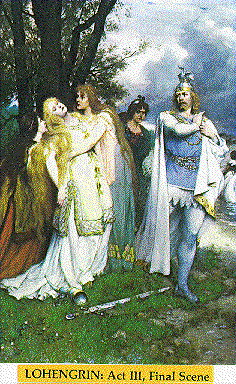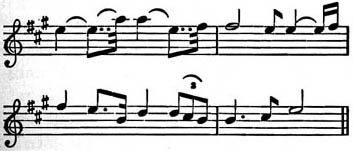Music with Ease > Operas of Richard Wagner > Music of Lohengrin (Wagner)
The Music of 'Lohengrin'
An Opera by Richard Wagner
In the case of a Wagnerian opera, it is always more or less difficult to deal with the music by itself, so bound up is it with the other elements of the drama. Wagner denied altogether the separateness of art, and practically said that if you understand his text, you ought to understand his musical setting of that text. He regarded the music as merely an interpretive instrument, as one only of several means of expression at the disposal of the lyrical dramatist -- a means and not an end. He insisted that the auditor should go to the theatre, not to hear music, but to witness a drama. Here is a deeply interesting letter addressed to a friend in 1850:
"An audience which assembles in a fair mood is satisfied as soon as it distinctly understands what is going forward, and it is a great mistake to think that a theatrical audience must have a special knowledge of music in order to receive the right impression of a musical drama. To this entirely erroneous opinion we have been brought by the fact that in opera music has wrongly been made the aim, while the drama was merely a means for the display of the music. Music, on the contrary, should do no more than contribute its full share toward making the drama more clearly and quickly comprehensible at every moment. While listening to a good – that is, a rational -- opera people should, so to speak, not think of the music at all, but only feel it in an unconscious manner, while their fullest sympathy should be wholly occupied by the action represented."
There we have Wagner’s own view, stated in his own words. He objects to anything like an exclusive study of his music, and insists that you should yourself find in it a reflection of the text. Liszt gave striking corroboration of Wagner’s principle when the wrote: "The distinguishing feature of the music of ‘Lohengrin’ is unity of conception and style; there is not a single melodic phrase, still less an ensemble, nor indeed a passage of any kind, the peculiar nature and true meaning of which would be understood if it were separated from its connection with the whole work. Every part connects, binds together and enhances the rest. All is of a piece, and so united that the parts cannot be torn asunder."

Lohengrin (Act III, Final Scene).
Artist: Ferdinand Leeke (1859-1925).
Practically, as Mr. Haweis, the "fiddling parson," observed long ago, the whole of "Lohengrin" is in the masterly Prelude. The descent of the Knight of the Swan from the jasper shrines of the sacred palace of Montsalvat, his holy mission to rescue Elsa from her false accusers -- his high and chivalric love -- his dignified trouble at being urged by her to reveal his name, that insatiable feminine curiosity which wrecks the whole-the darker scenes of treachery by which Elsa is goaded to press her fatal inquiry -- the magnificent climax of the First Act -- the sense of weird mystery that hangs about the appearance and reappearance of the swan, and the final departure of the glittering Knight of the Holy Grail-allegory of heavenly devotion stooping to lift up human love, and dashed with earth’s bitterness in the attempt: to those who understand the pathos, delicacy, and full intensity of the "Lohengrin" Prelude, this, and more, will become as vivid as life and emotion can make it.
In "Lohengrin" the leitmotiv system had not reached anything like the full development it was yet to reach in Wagner’s hands, but he had already used it in "The Flying Dutchman," and now it was nearing its full meaning. The most significant of all the motivs in the "Lohengrin" score is that of the Holy Grail, which strikes first on the ear in the Prelude. Here it is in its simplest form:

This theme, easily recognised, recurs again and again throughout. Then we have Lohengrin’s motiv, heard first when the knight appears in his shining armour, and reintroduced at various points --

The Warning motiv is first heard when Lohengrin solemnly charges Elsa never to ask his name --

In addition to these, there are a "Swan" motiv, a "Doubt" motiv, a :Judgment of God" motiv, and a special motiv for Elsa. It would take a great deal of space and music type to illustrate and explain these, and in the end little would be gained. The trained musician will recognise the leading themes for himself; the technically untrained yet intelligent and sympathetic listener will be satisfied if he realises the effects they are intended to produce.
A detailed account of the many musical beauties of "Lohengrin" would be, as Mr. Louis Elson observes, a complete description of the opera. Elsa’s recital of her dream, and its fulfillment by Lohrengrin’s arrival, form a climax more stirring than any on the operatic stage. Lohengrin’s impressive warning not to ask his name, and the malevolent passion of Ortrud, are typified in phrases that foreshadow all the condensed power of the guiding motives of later operas. The beautiful march to the church is melody as definite as any of the Italian sort, but supported by rich and attractive harmonies instead of the few simple chords of the earlier style. The prelude to the Third Act, the exquisite love-duet, and Lohengrin’s departure, keep up the standard of the work, and show that if Wagner discarded the older methods, he was able to substitute something better in their place. Here his music attains a freedom and an intensity of expression previously unknown. Those who listen attentively must surely be impressed by the many beautiful harmonies with which the work abounds; by the treatment of the touching love-scenes; by the melody (melos, as Wagner calls it) which, unfettered by traditional notions, is so freely encountered throughout. Above all, the magnificent orchestration cannot fail to arrest marked attention. The orchestra is here made a powerful agency to enrich, heighten, and intensify the dramatic expression of every character.
Music With Ease | About Us | Contact Us | Privacy | Sitemap | Copyright | Terms of Use © 2005-25 musicwithease.com. All Rights Reserved. |
